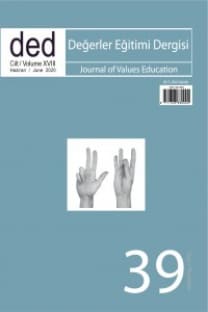Değer Eğitimi Akımlarına Genel Bir Bakış
Değer eğitimi akımları, Değer gerçekleştirme, Karakter eğitimi, Vatandaşlık eğitimi, Ahlak eğitimi
An Overview of Trends in Values Education
Values education approaches, Values realization, Character education, Address for correspondence - Kırıkkale University Kırıkkale/Turkey. E-Mail: oktayakbas@yahoo.com Citizenship education, Moral education.,
___
Akarsu, B. (1998). Mutluluk ahlakı. ahlak öğretileri-1. İstanbul: İnkılap Yayınevi.Bacanlı, H. (2005). Duygusal davranış eğitimi. Ankara: Nobel Yayın Dağıtım.
Bacanlı, H. (2000). Gelişim ve öğrenme. Ankara: Nobel Yayın Dağıtım.
Brimi, H. (2008). Academic instructors or moral guides? Moral education in America and teacher’s dilemma. The Claering House, 82(3), 125-130.
Dewey, J.(1959). Okulda ahlak eğitimi. (çev: A.Ferhan Oğuzkan). (22 03 2009 tarihinde www.dergiler.ankara.edu.tr/dergiler/40/496/5860.pdf -adresinden elde edilmiştir).
Duman, T., Karakaya, N, & Yavuz, N. (2001). Vatandaşlık bilgisi. Ankara: Gündüz Eğitim ve Yayıncılık.
Doğan, İ. (2002). Soyoloji: Kuramlar ve sorunlar. Ankara: Pegem Yayıncılık.
Ekşi, H. (2003). Temel insani değerlerin kazandırılmasında bir yaklaşım: Karakter eğitimi programları. Değerler Eğitimi Dergisi, 1(1), 79-96.
Erden, M., & Akman, Y. (1998). Gelişim, öğrenme, öğretme. Ankara: Arkadaş Yayınevi.
Fromm, E. (1993). Erdem ve mutluluk. Ahlak psikolojisi üzerine bir inceleme. (çev: A. Yörükan). İstanbul: Türkiye İş Bankası Yayınları.
Gauld, L., & Gauld, M. (2002). The biggest job we’ll ever have: the Hyde School program for character-based education and parentin. New York: Library of Congress Cataloging-in Publication Data.
Gough, R. (2001). Karekteriniz kaderinizdir (çev: G. Sezgi). Ankara: Hyb Yayınları.
Güngör, E. (1998). Ahlak psikolojisi ve sosyal ahlak. İstanbul: Ötüken Yayınevi.
Kanad, H. F. (1951). Deneysel pedagoji II. Ankara: Örnek Matbaası.
Kelley, T. (2003). Character educatıon, natural law, human happiness & succes., (12 12 2003 tarihinde www.drtomkelly.com adresinden elde edilmiştir).
Kerschensteiner, G. (1954). Karakter kavramı ve karakter terbiyesi (çev: H. Fikret Kanad). Ankara: Örnek Matbaası.
Kirschenbaum, H. (1995). 100 ways to enhance values and morality in schools and youth settings. Massachusetts: Allyn&Bacon Company.
Leming, J. S. (2000). Teaching values in social studies education, past practices and current trends. (02 01 2008 tarihinde Http://www.usoe.k12.ut.us/curr/char_ed/ fedproj/hist/ teaching.htm.adresinden elde edilmiştir).
Leming, J. S. (2008). Research and practice in moral and character education: Loosely coupled phenomena. Larry P. Nucci, Darcia Narvaez(Eds.). Handbook of Moral and Character Education. New York and London: Routledge Taylor and Francis Group.
Lickona, T. (1992). Educating for character (How our schools can teach respect and resposibility). New York: Bantam Books.
MEB. (2005). İlköğretim Fen ve Teknoloji Dersi (4-5. Sınıflar) Öğretim Programı ve Kılavuzu. Ankara: Devlet Kitapları Müdürlüğü.
Montagu, A. (1964). Çocuklarımıza ahlaki değerleri nasıl kazandırabilirsiniz? (çev. R. Öncül) Ankara: Milli Eğitim Basımevi.
Naylor, D., & Diem, R. (1987). Elementary and middle school social studies. New York: Random House.
Rewell, L., & Arthur, J. (2007). Character education in schools and the education of teachers. Journal of Moral Education, 36(1), 79-92.
Ryan, K. (1991). Moral and values education. Arieh Lewy(Ed.). The International Encyelopedia of Curriculum, Advences in Education, Pergaman Pres.
Ryan, K., & E. Bohlin, K. (1999). Building character in schools. California: Jossey-Bass Inc.
Simon, S. B., Leland, W H., & Kirschenbaum, H. (1972). Values clarification a handbook of practical strategies for teachers and students. New York: Hart Publishing Company, Inc.
Tatto, M.,Tapia, M.,Varela, A., & Rodriguez, M. (2001). Examining Mesico’s values education in a globally dynamic contest. Journal of Moral Education, 30(2), 173-198.
Yüksel, S. (2005). Kohlberg ve ahlak eğitiminde örtük program: Yeni ilköğretim programlarında yer alan ahlaki değerleri kazandırma için bir açılım. Kuram ve Uygulamada Eğitim Bilimleri Dergisi, 5(2), 329-338.
Welton, D. A., & Mallan, J. T.(1999). Children and their world. Boston: Houghton Mifflin Company.
- ISSN: 1303-880X
- Yayın Aralığı: 2
- Başlangıç: 2003
- Yayıncı: Ensar Neşriyat Ticaret A.Ş.
İngiltere - Amerika - Osmanlı Hattında Lancaster Öğretim Sistemi
Değer Eğitimi Akımlarına Genel Bir Bakış
Okul Müdürlerini İtibarlı Kılan Değerlerin Belirlenmesine Yönelik Nitel Bir Çalışma
Serbest Piyasa Ahi Evranları: Anadolu'da Yükselen Yeni Kalkınma Ahlakı
Öğretmen Adaylarının Değer Algılarının Farklı Değişkenler Açısından İncelenmesi
